All the solutions provided in McGraw Hill My Math Grade 5 Answer Key PDF Chapter 11 Lesson 4 Estimate and Measure Weight will give you a clear idea of the concepts.
McGraw-Hill My Math Grade 5 Answer Key Chapter 11 Lesson 4 Estimate and Measure Weight
The weight of an object is a measure of how heavy it is. Ounces and pounds are examples of units of measurement for weight.
Measure It
1. Estimate the weight of each object in ounces or pounds. Record your results in the table.
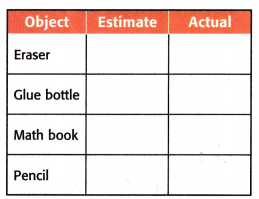
Answer:
First, we need to estimate the weight of the objects. Here sample answers are given:
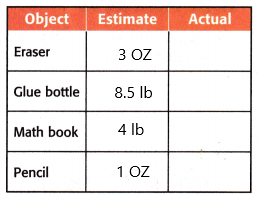
2. Measure the weight of each object. Place the eraser on one side of a balance. Set ounce or pound weights on the other side until the sides are level. Record the actual weight. Repeat this step for the other objects.

Answer:
Now write the actual readings of the objects. Now we have to measure the weights.

Try It
1. Place a 1-pound weight on one side of a balance.
2. Place 1 -ounce weights on the opposite side of the balance. Continue placing 1-ounce weights until the balance is equal. Use your results to complete the table.
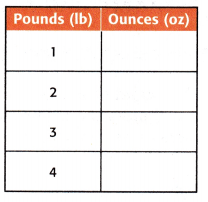
So, a 1 -pound weight is equal to _____________ ounces.
Answer:
1 pound is equal to 16 ounces.
1 lb = 16 oz
The mass m in ounces (oz) is equal to the mass m in pounds (lb) times 16:
m(oz) = m(lb) x 16
m(oz) = 1 x 16 = 16
m(oz) = 2 x 16 = 32
m(oz) = 3 x 16 = 48
m(0z) =4 x 16 = 64

Talk About It
Question 1.
Order the four objects you weighed in the activity from greatest to least weight.
Answer:
The eraser weight is 2 oz
if we convert ounce to pounds then
1 ounce (oz) is equal to 0.0625 pounds (lb).
1 oz = (1/16) lb = 0.0625 lb
The mass m in pounds (lb) is equal to the mass m in ounces (oz) divided by 16:
m(lb) = m(oz) / 16
m(lb) = 2 /16 = 0.125
The eraser in pounds is 0.125
The glue bottle is 9.2 lb
The math book is 6 lb
The pencil is 0.0125 lb
Now write the object weights from greatest to least:
The glue bottle, math book, eraser, and pencil.
Question 2.
Mathematical PRACTICE Explain to a Friend Is the total weight of the four objects you measured in the first activity greater than 2 pounds? Explain.
Answer: yes
I found the answer by adding the weights together.
0.125 + 9.2 + 6 + 0.0125 = 15.33
15.33 is greater than 2 pounds.
Hence, the total weight of the four objects is greater than 2 pounds.
Question 3.
Write a sentence describing the relationship usually found between an object’s size and weight.
Answer:
The weight is the measure of how heavy an object is. Weight is measured in standard customary units.
– weight depends on gravity, and gravity is different on other planets. This is why when you are floating in space, you are weightless. You still have mass, though.
customary units are pounds and ounces.
The mass of an object is the amount of material it contains. Mass is measured in standard metric units.
– gram and kilogram are two units used to measure mass in the metric system.
Practice It
Question 4.
Identify three objects in your classroom that you can use a balance to find their weights. Estimate each object’s weight. Then weigh each object and record the actual weight in the table below.
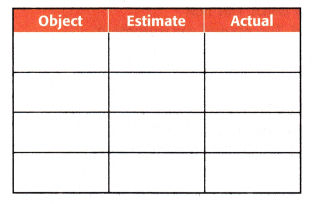
Answer:
The objects I would use a balance to find their weights are a chair, a computer, a book, and a pencil.
sample weights are given in the table:
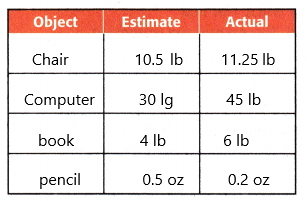
Compare. Use >, <, or = to make a true statement.
Question 5.
46 ounces ![]() 3 pounds
3 pounds
Answer: less than (<)
![]()
Explanation:
How to convert ounces to pounds:
1 ounce (oz) is equal to 0.0625 pounds (lb).
1 oz = (1/16) lb = 0.0625 lb
The mass m in pounds (lb) is equal to the mass m in ounces (oz) divided by 16:
m(lb) = m(oz) / 16
m(lb) = 46 / 16
m(lb) = 2.875
2.875 lb < 3 lb
Therefore, the answer is less than.
Question 6.
96 ounces ![]() 6 pounds
6 pounds
Answer: equal to(=)
96 ounces ![]() 6 pounds
6 pounds
Explanation:
How to convert ounces to pounds:
1 ounce (oz) is equal to 0.0625 pounds (lb).
1 oz = (1/16) lb = 0.0625 lb
The mass m in pounds (lb) is equal to the mass m in ounces (oz) divided by 16:
m(lb) = m(oz) / 16
m(lb) = 96 / 16
m(lb) = 6
6 lb < 6 lb
Therefore, the answer is equal to.
Question 7.
130 ounces ![]() 8 pounds
8 pounds
Answer: greater than (>)
![]()
Explanation:
How to convert ounces to pounds:
1 ounce (oz) is equal to 0.0625 pounds (lb).
1 oz = (1/16) lb = 0.0625 lb
The mass m in pounds (lb) is equal to the mass m in ounces (oz) divided by 16:
m(lb) = m(oz) / 16
m(lb) = 130 / 16
m(lb) = 8.125
8.125 lb > 8 lb
Therefore, the answer is greater than.
Question 8.
113 ounces ![]() 7 pounds
7 pounds
Answer: greater than (>)
Explanation:
How to convert ounces to pounds:
1 ounce (oz) is equal to 0.0625 pounds (lb).
1 oz = (1/16) lb = 0.0625 lb
The mass m in pounds (lb) is equal to the mass m in ounces (oz) divided by 16:
m(lb) = m(oz) / 16
m(lb) = 113 / 16
m(lb) = 7.0625
7.0625 lb > 7 lb
Therefore, the answer is greater than.
Question 9.
5 pounds ![]() 78 ounces
78 ounces
Answer: greater than (>)
Explanation:
1 pound (lb) is equal to 16 Ounces (oz).
1 lb = 16 oz
The mass m in ounces (oz) is equal to the mass m in pounds (lb) times 16:
m(oz) = m(lb) x 16
m(oz) = 5 x 16
m(oz) = 80
80 oz > 78 oz.
Therefore, the answer is greater than.
Question 10.
9 pounds ![]() 145 ounces
145 ounces
Answer: less than (<)
Explanation:
1 pound (lb) is equal to 16 Ounces (oz).
1 lb = 16 oz
The mass m in ounces (oz) is equal to the mass m in pounds (lb) times 16:
m(oz) = m(lb) x 16
m(oz) = 9 x 16
m(oz) = 144
144 oz > 145 oz.
Therefore, the answer is less than.
Question 11.
10 pounds ![]() 160 ounces
160 ounces
Answer: Equal to (=)
Explanation:
1 pound (lb) is equal to 16 Ounces (oz).
1 lb = 16 oz
The mass m in ounces (oz) is equal to the mass m in pounds (lb) times 16:
m(oz) = m(lb) x 16
m(oz) = 10 x 16
m(oz) = 160
160 oz > 160 oz.
Therefore, the answer is equal to (=).
Question 12.
12 pounds ![]() 196 ounces
196 ounces
Answer: less than (<)
Explanation:
1 pound (lb) is equal to 16 Ounces (oz).
1 lb = 16 oz
The mass m in ounces (oz) is equal to the mass m in pounds (lb) times 16:
m(oz) = m(lb) x 16
m(oz) = 12 x 16
m(oz) = 192
192 oz = 196 oz.
Therefore, the answer is equal to (=).
Apply It
Question 13.
Tim and Cameron measured the weight of the same calculator. Tim measured the calculator as 1 pound. Cameron measured the calculator as 13 ounces. Circle the greater measurement.
1 pound
13 ounces
Answer: 1 pound is greater.

Explanation:
The above-given:
The weight of the calculator Tim measured in pounds = 1
The weight of the calculator Cameron measured in ounces = 13
We need to circle the greatest measurement.
We all know that 1 pound is equal to 16 ounces.
1 lb = 16 oz
The mass m in ounces (oz) is equal to the mass m in pounds (lb) times 16:
m(oz) = m(lb) x 16
m(oz) = 1 x 16
m(oz) = 16
16 oz > 13 oz.
Therefore, the answer is greater than (>)
The greatest measurement is 1 pound which is measured by Tim.
Question 14.
Cara measured a dictionary twice. Her first measurement was 1 pound. The second measurement was 28 ounces. Circle the greater measurement.
1 pound
28 ounces
Answer: 28 ounces is the greatest measurement.

We all know that 1 pound is equal to 16 ounces.
1 lb = 16 oz
The mass m in ounces (oz) is equal to the mass m in pounds (lb) times 16:
m(oz) = m(lb) x 16
m(oz) = 1 x 16
m(oz) = 16
16 oz < 28 oz.
So 28 ounces is greater.
Therefore, the second measurement is greater.
Question 15.
If you are measuring a bag of sugar, would ounces or pounds give you a more precise measurement? Explain.
Answer: Ounces are more precise.
Explanation:
when it comes to estimating the lightest of objects, it is most appropriate to use ounces. they are the smallest unit of measurement in each of their respective systems.
It depends on the weight of sugar
1 pound = 16 ounces.
I would recommend using ounces, but pounds are easier to convert to other measurements.
Question 16.
Mathematical PRACTICE Be Precise Jeffrey measured the weight of his kitten. His first measurement was 34 ounces. His second measurement was 2 pounds. Use >, <,or = to make a true statement.
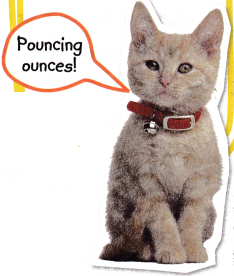
34 ounces ![]() 2 pounds
2 pounds
Answer: greater than (<)
![]()
Explanation:
How to convert ounces to pounds:
1 ounce (oz) is equal to 0.0625 pounds (lb).
1 oz = (1/16) lb = 0.0625 lb
The mass m in pounds (lb) is equal to the mass m in ounces (oz) divided by 16:
m(lb) = m(oz) / 16
m(lb) = 34 / 16
m(lb) = 2.125
2.125 lb > 2 lb
Therefore, the answer is greater than.
Hence, the first measurement is greater than the second measurement.
Question 17.
Mathematical PRACTICE Draw a Conclusion Compare and contrast pounds and ounces.
Answer:
Out of the two units, an ounce is smaller than a pound and both have traditionally been used for different purposes. Whereas ounces are used to measure precious metals and spices as they are required in smaller quantities, pounds are used to measure fruits and vegetables, and interestingly, the mass of people also.
Write About It
Question 18.
Why is an estimation of weight important in everyday life?
Answer:
– Estimation of weight is important in everyday life because it can be used to assess weight as a risk factor for the development of diseases.
– On a baseline level. measurements fall into the categories of weight. area. volume. length and even temperature. When we go to a market to purchase vegetables. we normally buy vegetables.
– Height and weight charts can determine whether you’re the correct weight for your height. Measuring height and weight accurately is important when monitoring an infant or child’s health.
McGraw Hill My Math Grade 5 Chapter 11 Lesson 4 My Homework Answer Key
Practice
Compare. Use >, <, or = to make a true statement.
Question 1.
30 ounces ![]() 2 pounds
2 pounds
Answer: less than (<)
Explanation:
How to convert ounces to pounds:
1 ounce (oz) is equal to 0.0625 pounds (lb).
1 oz = (1/16) lb = 0.0625 lb
The mass m in pounds (lb) is equal to the mass m in ounces (oz) divided by 16:
m(lb) = m(oz) / 16
m(lb) = 30 / 16
m(lb) = 1.875
1.875 lb < 2 lb
Therefore, the answer is less than.
Question 2.
98 ounces ![]() 6 pounds
6 pounds
Answer: greater than (>)
Explanation:
How to convert ounces to pounds:
1 ounce (oz) is equal to 0.0625 pounds (lb).
1 oz = (1/16) lb = 0.0625 lb
The mass m in pounds (lb) is equal to the mass m in ounces (oz) divided by 16:
m(lb) = m(oz) / 16
m(lb) = 98 / 16
m(lb) = 6.125
6.125 lb > 6 lb
Therefore, the answer is greater than.
Question 3.
11 pounds ![]() 176 ounces
176 ounces
Answer: equal to
Explanation:
1 pound (lb) is equal to 16 Ounces (oz).
1 lb = 16 oz
The mass m in ounces (oz) is equal to the mass m in pounds (lb) times 16:
m(oz) = m(lb) x 16
m(oz) = 11 x 16
m(oz) = 176
176 oz = 176 oz.
Therefore, the answer is equal to (=).
Question 4.
7 pounds ![]() 109 ounces
109 ounces
Answer: greater than (>)
Explanation:
1 pound (lb) is equal to 16 Ounces (oz).
1 lb = 16 oz
The mass m in ounces (oz) is equal to the mass m in pounds (lb) times 16:
m(oz) = m(lb) x 16
m(oz) = 7 x 16
m(oz) = 112
7 oz > 112 oz.
Therefore, the answer is greater than.
Vocabulary Check
Question 5.
Fill in the blank with the correct word to complete the sentence.
Weight is a measure of how _______________ an object is.
Answer: Heavy
– Weight is defined as the measure of how heavy an object is. The weights cannot be negative. Some weights can be zero, but not all of them, since division by zero is not allowed.
– The data elements which have a high weight will contribute more to the weighted mean as compared to the elements with a low weight.
Problem Solving
Question 6.
Kurt measured the weight of his ball python snake. His first measurement was 48 ounces. His second measurement was 3 pounds. Compare the two measurements. Use >, <, or = to make a true statement.
Answer: equal to(=)
The above-given:
The first measurement in ounces = 48
The second measurement in pounds = 3
Now compare
48 ounces and 3 pounds.
Explanation:
How to convert ounces to pounds:
1 ounce (oz) is equal to 0.0625 pounds (lb).
1 oz = (1/16) lb = 0.0625 lb
The mass m in pounds (lb) is equal to the mass m in ounces (oz) divided by 16:
m(lb) = m(oz) / 16
m(lb) = 48 / 16
m(lb) = 3
3 lb = 3 lb
Therefore, the answer is equal to(=)
Both measurements are equal.
Question 7.
Lori and Mindy measured the weight of their book bags. Lori measured her bag using pounds. Mindy measured her bag using ounces. Circle the measure that is more appropriate to measure the weight of the book bag.
pounds
ounces
Answer:

The pound is a much larger unit of measurement than an ounce since 16 units of an ounce make 1 pound.
The appropriate measure to weigh heavy objects is pounds. So, here the book bags would be heavier weight so pounds are used to measure the weight.
Question 8.
Tracy measured the weight of her hamster. Her first measurement was 13 ounces. Her second measurement was 1 pound. Which measurement is more precise?
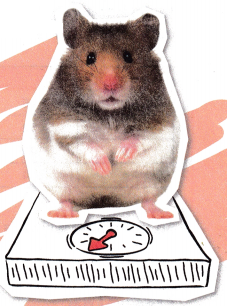
Answer:
The first measurement is 13 ounces
The second measurement is 1 pound
1 pound = 16 ounces.
In this case, 13 ounces is the more precise measurement. Because the hamster’s weight is not 1 pound or more than 1 pound it is less than a pound so ounces are precise.
Question 9.
Mathematical PRACTICE Be Precise Quinton measured the weight of his laptop. His first measurement was 94 ounces. His second measurement was 6 pounds. Compare the two measurements. Use >, <, or = to make a true statement.
Answer: less than(<)
The above-given:
The first measurement is 94 ounces
The second measurement is 6 pounds
Now compare
Explanation:
How to convert ounces to pounds:
1 ounce (oz) is equal to 0.0625 pounds (lb).
1 oz = (1/16) lb = 0.0625 lb
The mass m in pounds (lb) is equal to the mass m in ounces (oz) divided by 16:
m(lb) = m(oz) / 16
m(lb) = 94 / 16
m(lb) = 5.87
5.87 lb < 6 lb
Therefore, the answer is less than(<).
The first measurement is less than the second measurement.
Question 10.
If you are selling bags of candy, would you want to sell the candy in ounces or pounds? Explain.
Answer:
1 pound = 16 ounces
It depends on the number of bags and bag weight.
It would be in pounds.
The pound is a considerably larger measurement of mass,
In large amounts, we usually make a sale in pounds only.